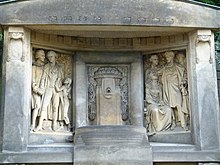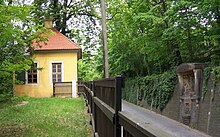Schiller house

The Schillerhäuschen is a literary museum in Dresden , which is dedicated to the important German poet and playwright Friedrich Schiller . It was set up in a small building in which Schiller is said to have stayed and is part of the network of museums in the city of Dresden .
The Schillerhäuschen is by far the smallest museum in Dresden and has been looked after by members of the Dresden Community Foundation on a voluntary basis since it reopened in 2005 .
Location
The museum is located in a pavilion-like garden house at Schillerstraße 19 in the Loschwitz district in the east of the Saxon capital. It is located halfway up the Dresden Elbe slopes, only about 500 meters north of the Blue Wonder , a little below the confluence of Schevenstrasse. Its location used to belong to the Körnerchen Weinberg, which ran uphill from the Körnerweg on the Elbe .
Other Dresden museums in the area are the Leonhardi Museum and the Josef Hegenbarth Archive .
exhibition
An exhibition on Schiller's work in Dresden is shown in the Schillerhäuschen. His works are documented in various documents and images, including manuscripts, excerpts from the Schiller's poems made in Dresden and reproductions of paintings. The inventory also includes Schiller relics, which used to be on display in the Körner Museum in the Inner Neustadt , which fell victim to the air raids on Dresden in 1945 .
The exhibition also includes information on the group of artists around Schiller and the art patron Christian Gottfried Körner . On this point, it complements the Kügelgenhaus - Museum of the Dresden Romanticism on Hauptstrasse in Dresden, which has a room dedicated to the same topic.
history
Schiller in Dresden
Friedrich Schiller had known the art patron Christian Gottfried Körner since June 1784 , who was enthusiastic about Schiller's dramas and helped him out of a financial emergency. After Schiller had already stayed several times in the summer of 1785 in a residence of Körner in Leipzig or its current district of Gohlis , he accepted Körner's invitation to Dresden. Schiller arrived there at the beginning of September 1785. At first he lived in the “Goldener Engel” inn. On September 12, 1785, Schiller visited the Körner family, who lived in a town house in the Inner New Town between 1783 and 1793 . This building, which was later called the Körnerhaus and housed a museum named after Körner, stood on the former Kohlmarkt near the Japanese Palace and was destroyed in 1945. After Schiller, Körner received among others Wolfgang Amadeus Mozart (1789) and Johann Wolfgang von Goethe (August 1790).
As a result, Körner generously sponsored the talented poet Schiller, who now stayed in Dresden for two years. In the summers of 1786 and 1787, Schiller stayed for a long time in the summer residence acquired by Körner in 1785, which was located on today's Körnerweg in Loschwitz near Dresden, which was still independent at the time. Behind this house, on the slopes of the Elbe, there was a vineyard, at the upper end of which there was a small garden house at the level of what was then Moritzburg-Pillnitzer Weg . This is today's Schillerhäuschen museum.
It is uncertain and, due to the destruction of the Körner Museum, no longer verifiable whether Schiller ever stayed in the garden shed. All that has been proven is that Friedrich Schiller stayed in Körner's town house and in the main building of his summer residence. On the other hand, Schiller mainly pursued his work, composing and composing dramas in his own city apartment near Neustädter Markt . It therefore remains questionable whether he actually wrote parts of the well-known works An die Freude and Don Karlos that were written during his time in Dresden, or whether he also wrote articles for his magazine Thalia in today's Schillerhäuschen. It is likely, however, that he was inspired by the view from the vineyard over the Elbe valley - the landscape is known as the former world cultural heritage of Dresden Elbe valley . From here he made several trips into the surrounding area, including today's Schillergarten on the other side of the Elbe in Blasewitz , where he met Johanne Justine Renner , whom he immortalized as "Gustel from Blasewitz" in Wallenstein's camp . After Schiller increasingly displeased his dependence on the patron Körner and the conditions in Dresden at the time, he left the Saxon royal seat in July 1787 for Weimar .
From August to September 1801, Schiller was again and for the last time in Dresden at Körner's guest house, staying in his summer residence in Loschwitz.
Schillerhäuschen as a museum

Little is known about the origin of today's Schillerhäuschen. If it actually already existed during Schiller's time in Dresden, it may have been destroyed in the course of the Battle of Dresden in August 1813 during the Wars of Liberation . In any case, it was not mentioned when a property was sold in 1818. It is therefore assumed that the Schillerhäuschen was rebuilt in its current form around 1820 or was even completely rebuilt at that time and was therefore only declared as Schiller's place of residence in retrospect during the Romantic era .
In 1823 an engraving appeared in a paperback book with the title “Pavillon auf Körner's Weinberg, where F. v. Schiller lived ”. From the title it cannot be clearly deduced whether Schiller's place of residence refers to the pavilion, i.e. the Schiller house, or the vineyard or its main building on Körnerweg. On the 50th anniversary of Friedrich Schiller's death, a plaque was put up on the Schillerhäuschen in 1855 to commemorate Schiller's stay. However, this only happened because the then property owner refused to have the memorial plaque attached to the main house on Körnerweg, which ultimately also contributed to the lack of clarity about Schiller's real workplace. On the same day next to the Schillerhäuschen one were Schiller oak and grains Linde planted.
In the course of the 19th century, a memorial was created on the Schillerhäuschen for Schiller's years in Dresden, which underwent little change in the 20th century. Part of the Schiller House was reconstructed in 1986. After 2000 it was more and more threatened with decay and remained closed from 2002 because there was no public funding for the comprehensive renovation.
In the following years the Dresden Community Foundation took the initiative to reopen the Schillerhäuschen. In doing so, she cooperated in a joint working group with the municipal museums , to which the Schillerhäuschen belongs, and with German students from the TU Dresden . This enabled the exhibition to be completely redesigned. The building was also secured. A few days before the 200th anniversary of Friedrich Schiller's death, the Schiller House was reopened in early May 2005. Since then, the community foundation has acted as a contact and supervisor and provides voluntary museum supervisors.
Schiller Monument
Opposite the Schillerhäuschen there was originally a white Schiller statue. It was donated by private individuals and depicted Friedrich Schiller seated, holding a book in his left hand. The Schiller statue was a plaster replica of the Schiller statue at the Semper Opera House , which the sculptor Ernst Rietschel had created. It had to be painted annually with white oil paint, which should prevent decay. Around 1912 the trace of the memorial was lost and the Schiller-Körner memorial was inaugurated on May 18, 1912. From the Saxon King Friedrich August III. the bon mot is handed down: "It's good that the white Schiller is finally gone, my 'Brauner' was always so afraid."
Schiller-Körner Monument

On the side of Schillerstrasse opposite the Schillerhäuschen, the sculptor Oskar Rassau created the Schiller-Körner Monument, completed in 1913, as one of his last works based on a design by the architect Martin Pietzsch . It is also known as the Schiller-Körner-Brunnen , as there is a small fountain in the middle of the monument, which was originally fed from a source of the mountain stream behind. The sculptural work was carried out by Adolf Schwarz . The memorial is located as a high relief on a retaining wall, is constructed like a temple and depicts two figural scenes. It commemorates Schiller's last visit in 1801 and his role model effect on Christian Gottfried Körner's son Theodor , who in 1813 went to war against Napoléon as a member of Lützow's Freikorps Bonaparte's troops withdrew and fell that same year.
Web links
- The Schillerhäuschen , branch museum on the website of the Dresden City Museum
- Schillerhäuschen on the website of the museums of the city of Dresden
- Photos of the Schillerhäuschen in the Deutsche Fotothek
swell
- dresdner-stadtteile.de: Schillerstraße
- Kulturbox.de: Schillerhäuschen
- Article Schillerhäuschen in Stadtwiki Dresden
Individual evidence
- ^ August Kotzsch: photographer in Loschwitz near Dresden . Verlag der Kunst, Dresden 1986, p. 269.
- ^ Sächsische Zeitung, January 4, 2010, page 17
Coordinates: 51 ° 3 ′ N , 13 ° 49 ′ E





